Synthesis and Characterization of High-Energy Anti-Perovskite Compounds Cs3X[B12H12] Based on Cesium Dodecahydro-Closo-Borate with Molecular Oxoanions (X− = [NO3]−, [ClO3]− and [ClO4]−)
Abstract
:1. Introduction
2. Results and Discussion
2.1. Crystallography
2.2. Raman Spectroscopy
2.3. Thermal Analysis
3. Materials and Methods
3.1. Synthesis
3.2. Devices
3.2.1. X-ray Crystallography
3.2.2. Thermal Analysis
3.2.3. Raman Spectroscopy
4. Conclusions
Supplementary Materials
Author Contributions
Funding
Data Availability Statement
Acknowledgments
Conflicts of Interest
References
- Arul, N.S.; Nithya, V.D. Revolution of Perovskite; Springer: Singapore, 2020. [Google Scholar]
- Park, N.G. Halide Perovskite Photovoltaics: History, Progress, and Perspectives. MRS Bull. 2018, 43, 527–533. [Google Scholar] [CrossRef]
- Han, J.; Zhu, X.; Zhang, J.; Cai, S.; Guo, J.; Zhou, Y.; Zhao, J.; Wang, P.; Wang, L.; Wei, X. Superconducting-Insulating Quantum Phase Transition Associated with Valence Change in Compressed Perovskite Bismuth-Oxides. arXiv 2023, arXiv:2305.08406. [Google Scholar]
- Krivovichev, S.V. Minerals with Antiperovskite Structure: A Review. Z. Kristallogr. 2008, 223, 109–113. [Google Scholar] [CrossRef]
- Zhao, Y.; Daemen, L.L. Superionic Conductivity in Lithium-Rich Anti-Perovskites. J. Am. Chem. Soc. 2012, 134, 15042–15047. [Google Scholar] [CrossRef]
- Ullah, I.; Murtaza, G.; Khenata, R.; Mahmood, A.; Muzzamil, M.; Amin, N.; Saleh, M. Structural and Optoelectronic Properties of X3ZN (X = Ca, Sr, Ba; Z = As, Sb, Bi) Anti-Perovskite Compounds. J. Electron. Mater. 2016, 45, 3059–3068. [Google Scholar] [CrossRef]
- Zhu, Y.; Chen, G.; Zhong, Y.; Chen, Y.; Ma, N.; Zhou, W.; Shao, Z. A Surface-Modified Antiperovskite as an Electrocatalyst for Water Oxidation. Nat. Commun. 2018, 9, 2326. [Google Scholar] [CrossRef]
- Han, D.; Zhu, B.; Cai, Z.; Spooner, K.B.; Rudel, S.S.; Schnick, W.; Bein, T.; Scanlon, D.O.; Ebert, H. Discovery of Multi-Anion Antiperovskites X6NFSn2 (X = Ca, Sr) as Promising Thermoelectric Materials by Computational Screening. Matter 2023, 7, 158–174. [Google Scholar] [CrossRef]
- Ulas, A.; Kuo, K.K.; Gotzmer, C. Ignition and Combustion of Boron Particles in Fluorine-Containing Environments. Combust. Flame 2001, 127, 1935–1957. [Google Scholar] [CrossRef]
- Chintersingh, K.-L.; Nguyen, Q.; Schoenitz, M.; Dreizin, E.L. Combustion of Boron Particles in Products of an Air-Acetylene Flame. Combust. Flame 2016, 172, 194–205. [Google Scholar] [CrossRef]
- Cao, W.; Guo, W.; Ding, T.; Han, Y.; Li, M.; Gao, D.; Guo, X. LASER Ablation of Aluminized RDX with Added Ammonium Perchlorate or Ammonium Perchlorate/Boron/Magnesium Hydride. Combust. Flame 2020, 221, 194–200. [Google Scholar] [CrossRef]
- Dreizin, E.L. Metal-Based Reactive Nanomaterials. Prog. Energy Combust. Sci. 2009, 35, 141–167. [Google Scholar] [CrossRef]
- Liu, L.; He, G.; Wang, Y. Thermal Reaction Characteristics of the Boron Used in the Fuel-Rich Propellant. J. Therm. Anal. Calorim. 2013, 114, 1057–1068. [Google Scholar] [CrossRef]
- Mi, X.; Goroshin, S.; Higgins, A.J.; Stowe, R.; Ringuette, S. Dual-Stage Ignition of Boron Particle Agglomerates. Combust. Flame 2013, 160, 2608–2618. [Google Scholar] [CrossRef]
- Wunderlich, J.A.; Lipscomb, W.N. Structure of B12H122− Ion. J. Am. Chem. Soc. 1960, 82, 4427–4428. [Google Scholar] [CrossRef]
- Sivaev, I.B.; Bregadze, V.I.; Sjöberg, S. Chemistry of Closo-Dodecaborate Anion [B12H12]2−: A Review. Collect. Czechoslov. Chem. Commun. 2002, 67, 679–727. [Google Scholar] [CrossRef]
- Tiritiris, I. Untersuchungen zu Reaktivität, Aufbau und Struktureller Dynamik von Salzartigen Closo-Dodekaboraten. Ph.D. Thesis, University of Stuttgart, Stuttgart, Germany, 2004. [Google Scholar]
- Tiritiris, I.; Weidlein, J.; Schleid, T. Dodekahydro-closo-Dodekaborat-Halogenide der schweren Alkalimetalle mit der Formel M3X[B12H12] (M = K–Cs, NH4; X = Cl und Br) / Dodecahydro-closo-Dodecaborate Halides of the Heavy Alkali Metals with the Formula M3X[B12H12] (M = K–Cs, NH4; X = Cl and Br). Naturforsch. B 2005, 60, 627–639. [Google Scholar] [CrossRef]
- Tiritiris, I.; Schleid, T. Die Dodekahydro-closo-Dodekaborate M2[B12H12] der schweren Alkalimetalle (M+ = K+, Rb+, NH4+, Cs+) und ihre formalen Iodid-Addukte M3I[B12H12] (≡ MI·M2[B12H12]). Z. Anorg. Allg. Chem. 2003, 629, 1390–1402. [Google Scholar] [CrossRef]
- Schouwink, P.; Sadikin, Y.; van Beek, W.; Černý, R. Experimental Observation of Polymerization from BH4− to B12H122− in Mixed-Anion A3BH4B12H12 (A = Rb+, Cs+). Int. J. Hydrogen Energy 2015, 40, 10902–10907. [Google Scholar] [CrossRef]
- Bareiß, K.U.; Bette, S.; Enseling, D.; Jüstel, T.; Schleid, T. Extraordinary Intense Blue Tl+ Lone-Pair Photoluminescence from Thallium(I) Chloride Hydroborate Tl3Cl[B12H12]. Dalton. Trans. 2022, 51, 13331–13341. [Google Scholar] [CrossRef]
- Fischer, D.; Klapötke, T.M.; Stierstorfer, J. 1, 5-Di (Nitramino) Tetrazole: High Sensitivity and Superior Explosive Performance. Angew. Chem. Int. Ed. 2015, 54, 10299–10302. [Google Scholar] [CrossRef] [PubMed]
- Klapötke, T.M.; Minar, N.K.; Stierstorfer, J. Investigations of Bis(Methyltetrazolyl) Triazenes as Nitrogen-Rich Ingredients in Solid Rocket Propellants—Synthesis, Characterization and Properties. Polyhedron 2009, 28, 13–26. [Google Scholar] [CrossRef]
- Steinhauser, G.; Klapötke, T.M. “Green” Pyrotechnics: A Chemists’ Challenge. Angew. Chem. Int. Ed. 2008, 47, 3330–3347. [Google Scholar] [CrossRef]
- Aghaei Hakkak, R.; Schleid, T. Crystal Structure and Thermal Behavior of Three Potential High-Energy Compounds of Hydro-Closo-Borates with Guanidinium. J. Solid State Chem. 2023, 329, 124416. [Google Scholar] [CrossRef]
- Zimmermann, L.W.; Aghaei Hakkak, R.; Ranjbar, M.; Schleid, T. Crystal Structures and Thermal Analyses of Three New High-Energy Hydrazinium Hydro-Closo-Borates. Int. J. Hydrogen Energy 2024, 16, 1469–1477. [Google Scholar] [CrossRef]
- Rao, M.H.; Muralidharan, K. Closo-Dodecaborate (B12H12)2− Salts with Nitrogen Based Cations and Their Energetic Properties. Polyhedron 2016, 115, 105–110. [Google Scholar] [CrossRef]
- Shang, Y.; Chen, S.L.; Yu, Z.H.; Huang, R.K.; He, C.-T.; Ye, Z.-M.; Zhang, W.-X.; Chen, X.-M. Silver(I)-Based Molecular Perovskite Energetic Compounds with Exceptional Thermal Stability and Energetic Performance. Inorg. Chem. 2022, 61, 4143–4149. [Google Scholar] [CrossRef]
- Zhou, J.; Ding, L.; Zhao, F.; Wang, B.; Zhang, J. Thermal Studies of Novel Molecular Perovskite Energetic Material (C6H14N2)[NH4(ClO4)3]. Chin. Chem. Lett. 2020, 31, 554–558. [Google Scholar] [CrossRef]
- Shang, Y.; Huang, R.K.; Chen, S.L.; He, C.T.; Yu, Z.H.; Ye, Z.M.; Zhang, W.X.; Chen, X.M. Metal-Free Molecular Perovskite High-Energetic Materials. Cryst. Growth Des. 2020, 20, 1891–1897. [Google Scholar] [CrossRef]
- Abrahams, S.C.; Bernstein, J.L. Remeasurement of Optically Active NaClO3 and NaBrO3. Acta Crystallogr. 1977, B33, 3601–3604. [Google Scholar] [CrossRef]
- Sass, R.L.; Vidale, R.; Donohue, J. Interatomic Distances and Thermal Anisotropy in Sodium Nitrate and Calcite. Acta Crystallogr. 1957, 10, 567–570. [Google Scholar] [CrossRef]
- Fugel, M.; Malaspina, L.A.; Pal, R.; Thomas, S.P.; Shi, M.W.; Spackman, M.A.; Sugimoto, K.; Grabowsky, S. Revisiting a Historical Concept by Using Quantum Crystallography: Are Phosphate, Sulfate and Perchlorate Anions Hypervalent? Chem. Eur. J. 2019, 25, 6523–6532. [Google Scholar] [CrossRef]
- Lucas, B.W. The Structure (Neutron) of Phase II Caesium Nitrate at 298 K, CsNO3. Acta Crystallogr. 1983, C39, 1591–1594. [Google Scholar] [CrossRef]
- Griesemer, S.D.; Ward, L.; Wolverton, C. High-Throughput Crystal Structure Solution Using Prototypes. Phys. Rev. Mater. 2021, 5, 105003. [Google Scholar] [CrossRef]
- Granzin, J. Refinement of the Crystal Structures of RbClO4 and CsClO4. Z. Kristallogr. 1988, 184, 157–160. [Google Scholar] [CrossRef]
- Sist, M.; Fischer, K.F.F.; Kasai, H.; Iversen, B.B. Low-Temperature Anharmonicity in Cesium Chloride (CsCl). Angew. Chem. Int. Ed. 2017, 56, 3625–3629. [Google Scholar] [CrossRef]
- Demont, A.; Prestipino, C.; Hernandez, O.; Elkaïm, E.; Paofai, S.; Naumov, N.; Fontaine, B.; Gautier, R.; Cordier, S. Unprecedented Electron-Poor Octahedral Ta6 Clusters in a Solid-State Compound: Synthesis, Characterisations and Theoretical Investigations of Cs2BaTa6Br15O3. Chem. Eur. J. 2013, 19, 12711–12719. [Google Scholar] [CrossRef]
- Smakula, A.; Kalnajs, J. Precision Determination of Lattice Constants with a Geiger-Counter X-ray Diffractometer. Phys. Rev. 1955, 99, 1737–1743. [Google Scholar] [CrossRef]
- Aghaei Hakkak, R.; Schleid, T. Low-Temperature Measurement of the Unexpected Hydrate Cs2[B12H12]. Acta Crystallogr. 2023, A79. in press. [Google Scholar]
- Goto, A.; Hondoh, T.; Mae, S. The Electron Density Distribution in Ice Ih Determined by Single-crystal X-ray Diffractometry. J. Chem. Phys. 1990, 93, 1412–1417. [Google Scholar] [CrossRef]
- Roobottom, H.K.; Jenkins, H.D.B.; Passmore, J.; Glasser, L. Thermochemical Radii of Complex Ions. J. Chem. Educ. 1999, 76, 1570–1573. [Google Scholar] [CrossRef]
- Feldmann, C.; Jansen, M. Darstellung und Kristallstruktur von Cs3ClO/Preparation and Crystal Structure of Cs3ClO. Z. Naturforsch. 1995, 50b, 1415–1416. [Google Scholar] [CrossRef]
- Feldmann, C.; Jansen, M. Zur kristallchemischen Ähnlichkeit von Aurid- und Halogenid-Ionen. Z. Anorg. Allg. Chem. 1995, 621, 1907–1912. [Google Scholar] [CrossRef]
- Feldmann, C.; Jansen, M. Zur Kenntnis neuer ternärer Oxide mit anionischem Gold. Z. Anorg. Allg. Chem. 1995, 621, 201–206. [Google Scholar] [CrossRef]
- Tiritiris, I.; Schleid, T.; Müller, K. Solid-State NMR Studies on Ionic closo-Dodecaborates. Appl. Magn. Reson. 2007, 32, 459–481. [Google Scholar] [CrossRef]
- Zapata, F.; García-Ruiz, C. The Discrimination of 72 Nitrate, Chlorate and Perchlorate Salts Using IR and Raman Spectroscopy. Spectrochim. Acta 2018, A189, 535–542. [Google Scholar] [CrossRef]
- Klapötke, T.M. Energetic Materials Encyclopedia; de Gruyter: Berlin, Germany, 2018. [Google Scholar]
- Sheldrick, G.M. SHELXS-97 and SHELXL-97, Programs for Crystal Structure Solution and Refinement; University of Göttingen: Göttingen, Germany, 1997. [Google Scholar]
- Sheldrick, G.M. A Short History of SHELX. Acta Crystallogr. 2008, A64, 112–122. [Google Scholar] [CrossRef]
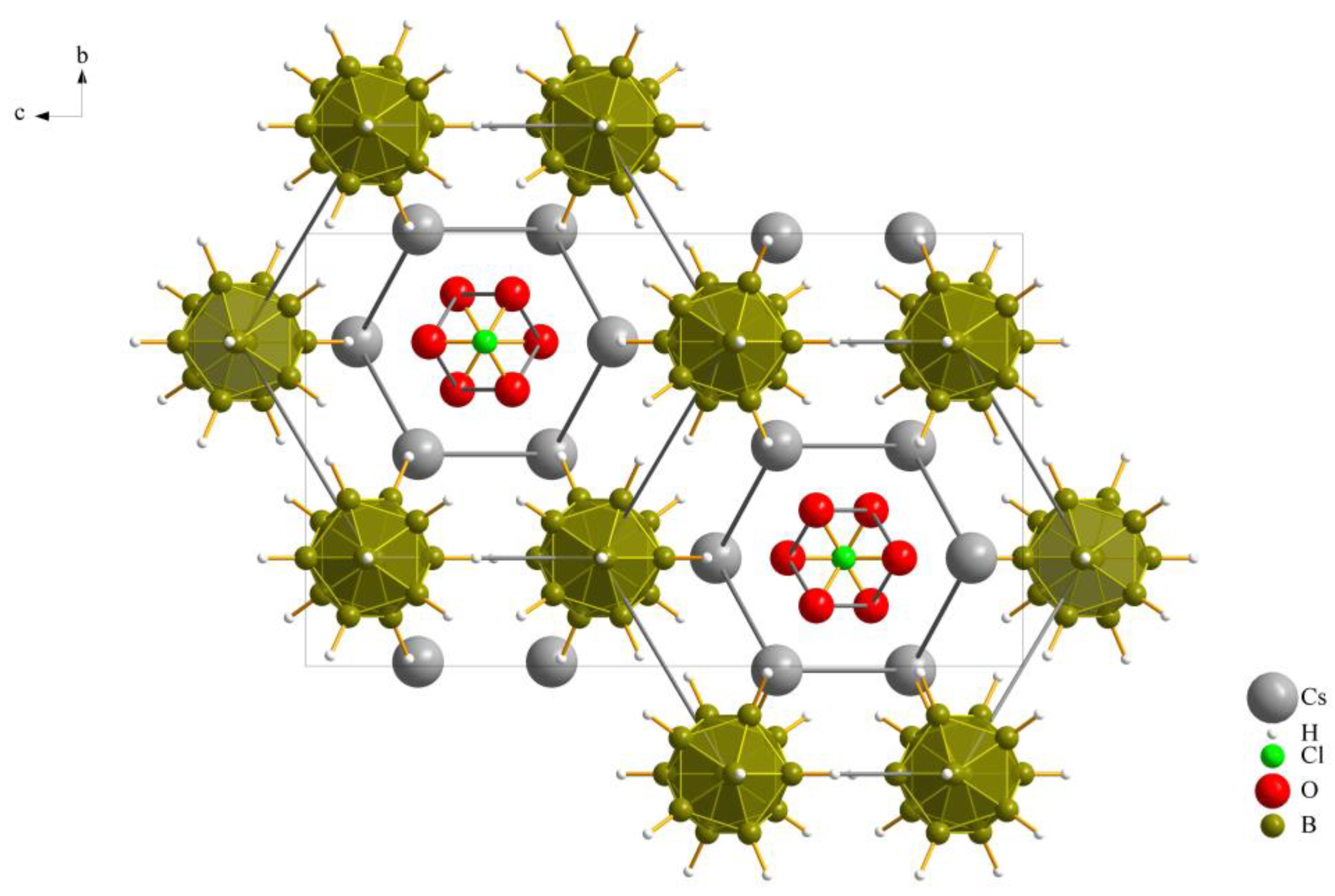

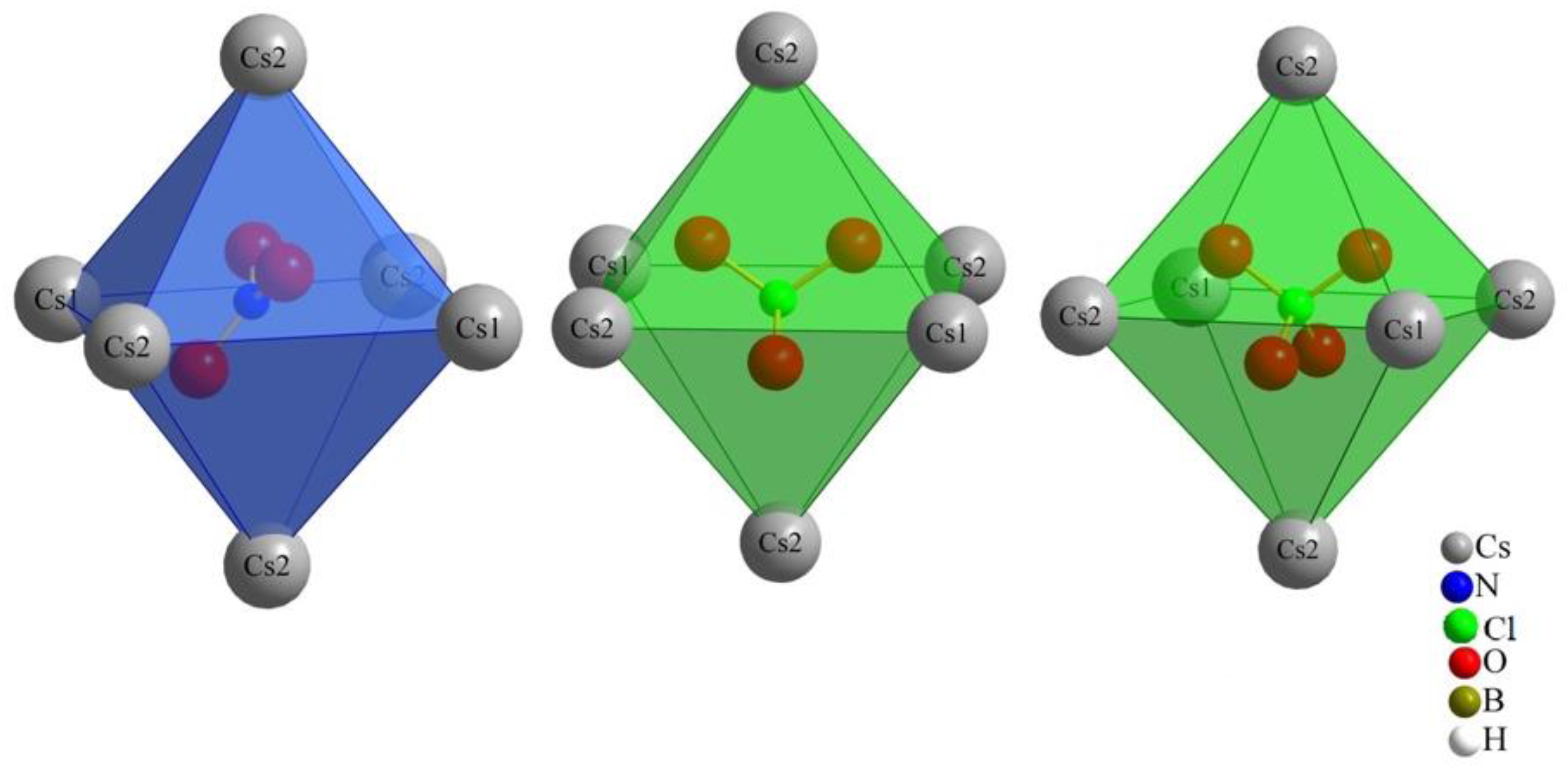
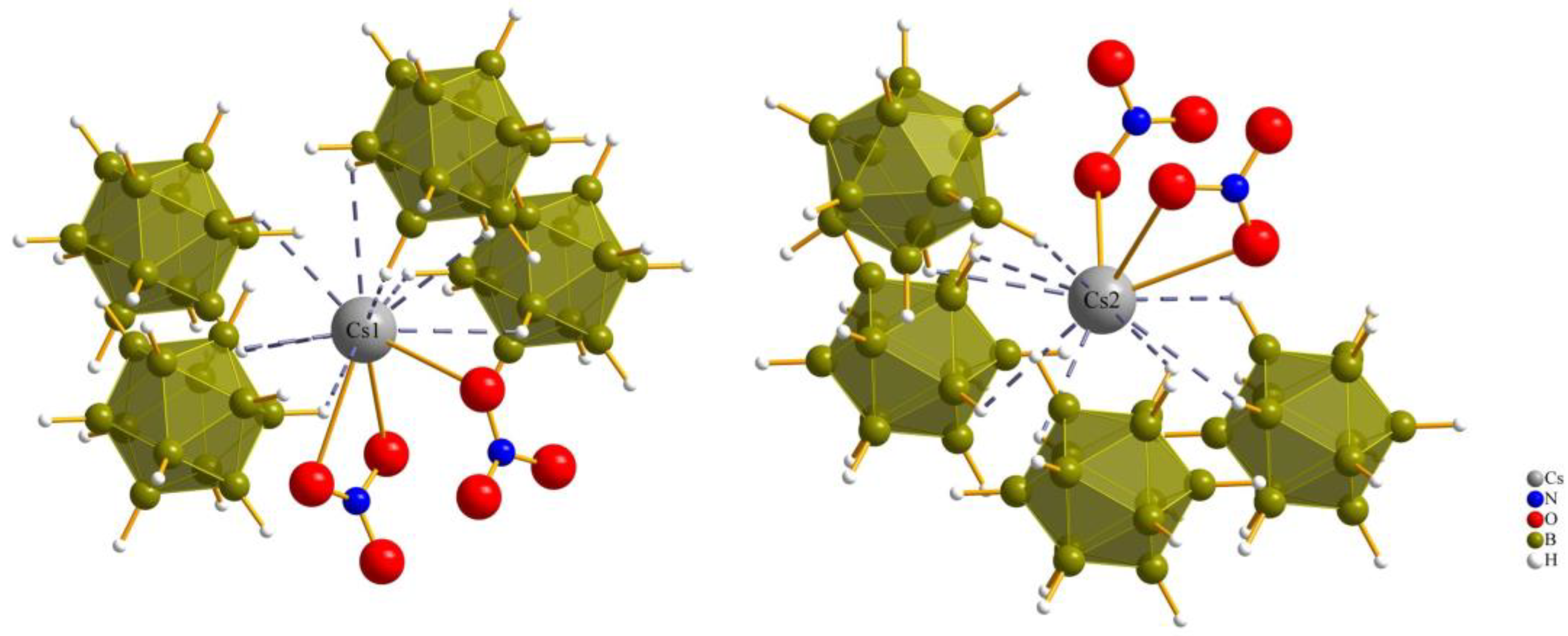

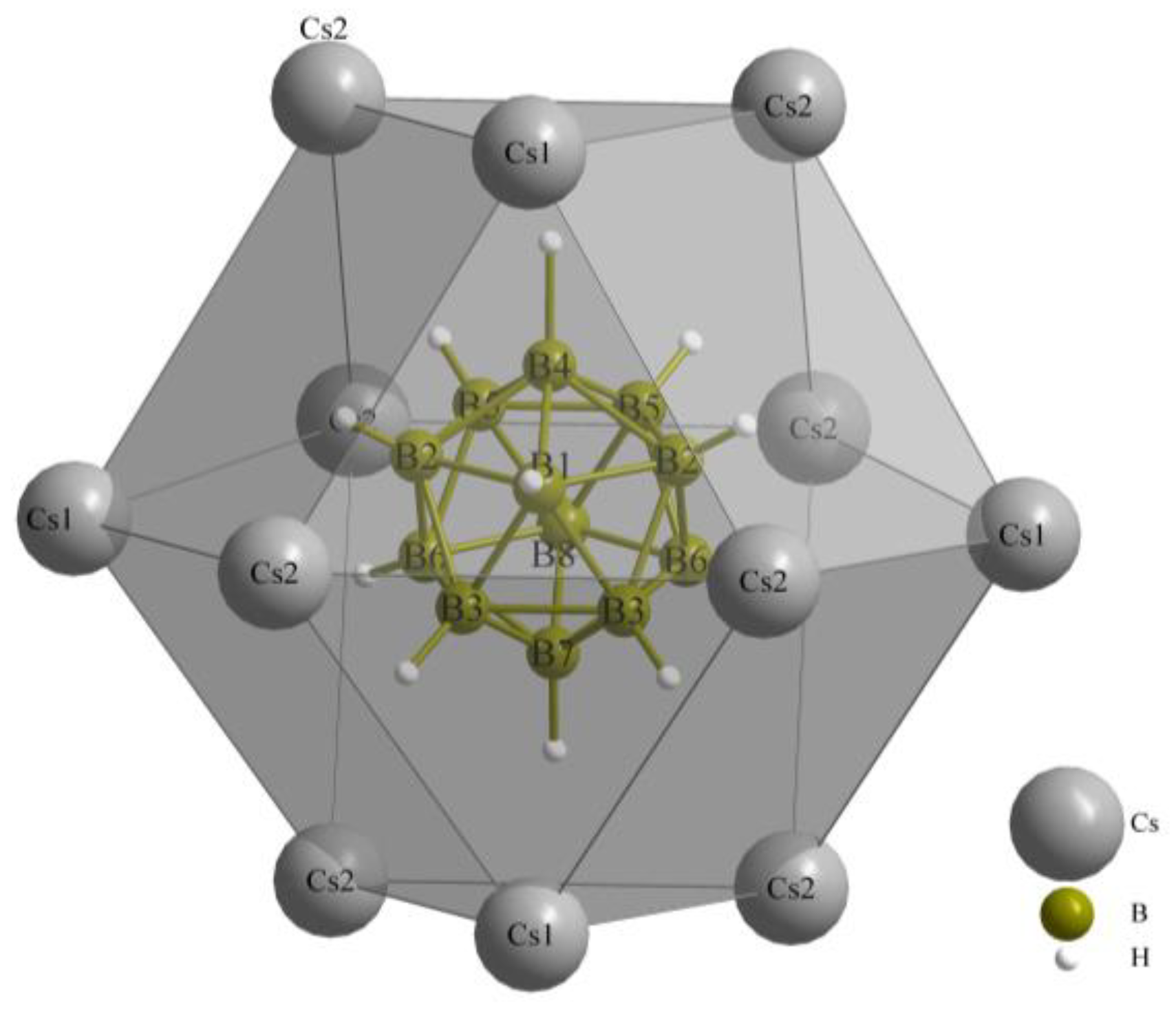
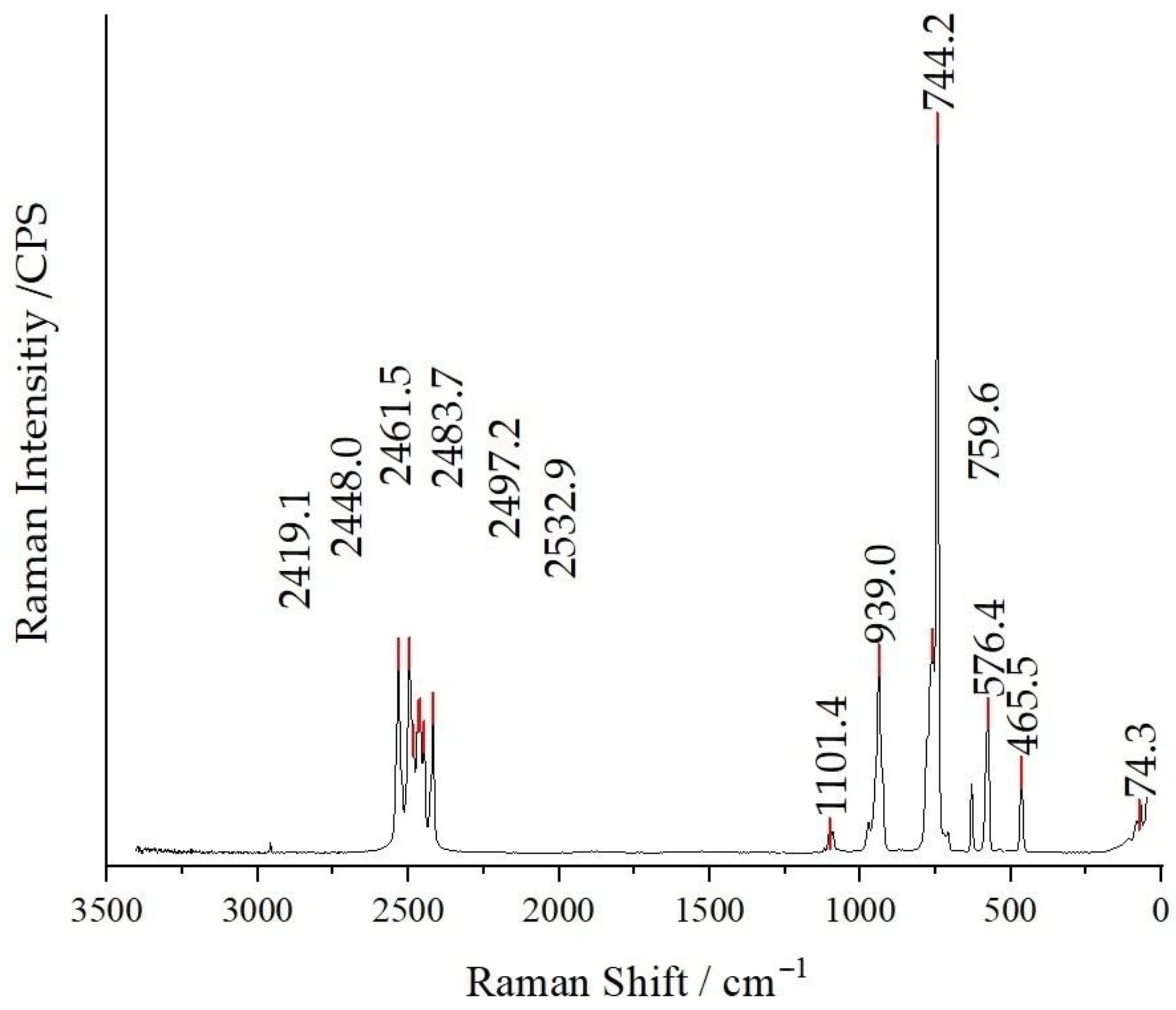
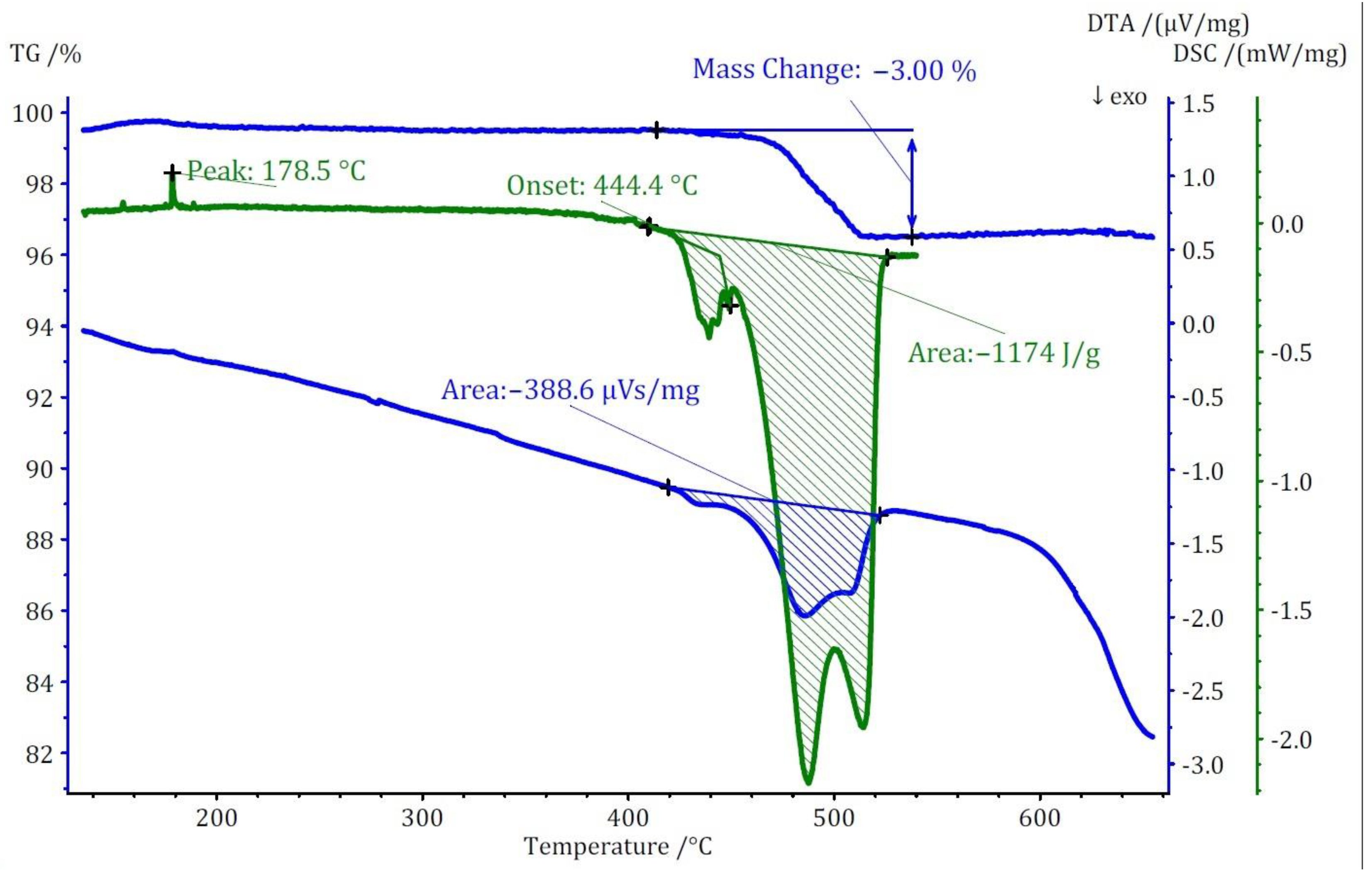
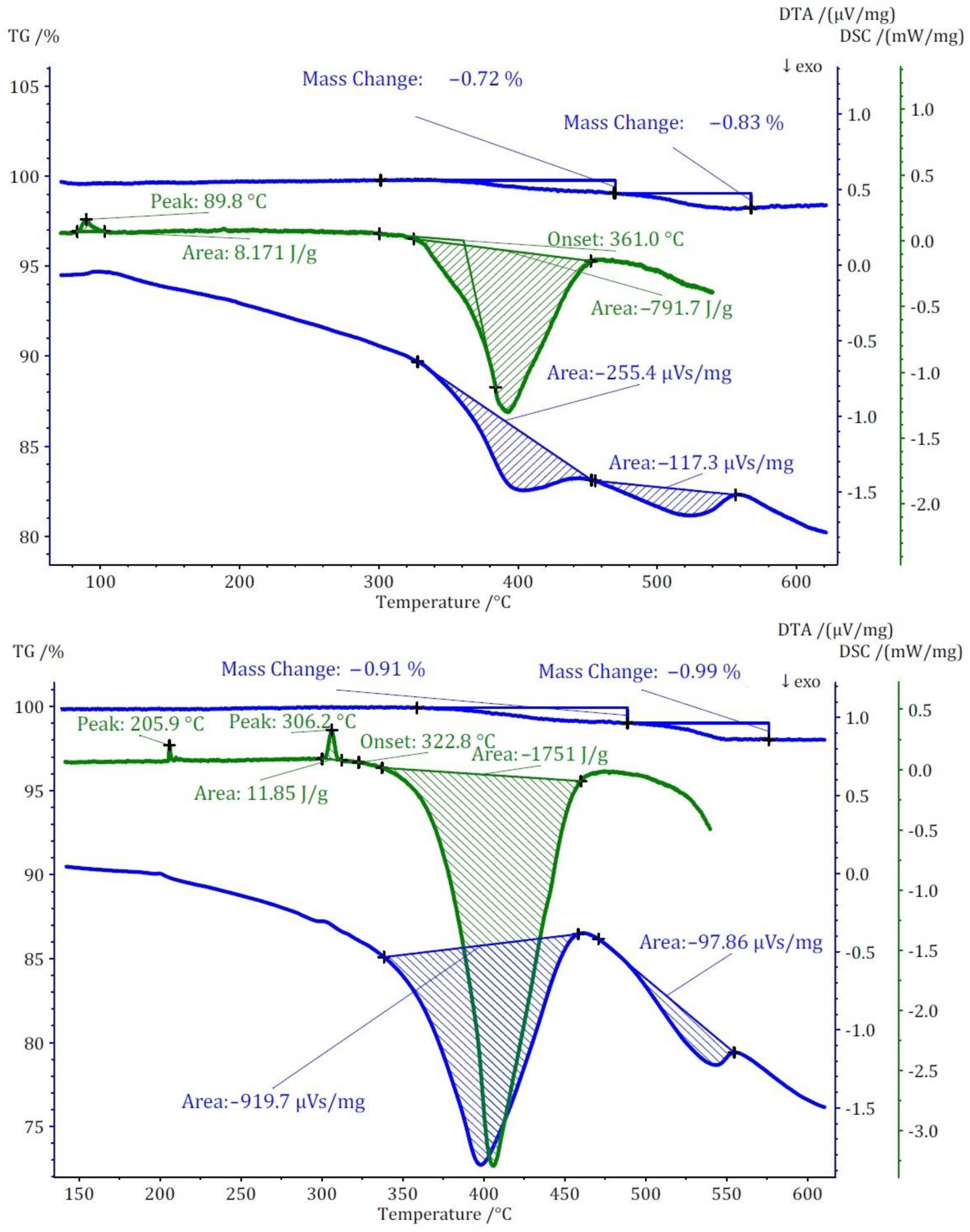
| Compound | Cs3[NO3][B12H12] (I) | Cs3[ClO3][B12H12] (II) | Cs3[ClO4][B12H12] (III) |
|---|---|---|---|
| temperature, K | 293 | 293 | 293 |
| crystal system | orthorhombic | orthorhombic | orthorhombic |
| space group | Pnma | Pnma | Pnma |
| a, pm | 848.51(5) | 841.25(5) | 892.46(5) |
| b, pm | 1045.62(6) | 1070.31(6) | 1054.89(6) |
| c, pm | 1761.38(9) | 1776.84(9) | 1718.53(9) |
| Dcal, g cm−3 | 2.561 | 2.591 | 2.627 |
| μ(MoKα), mm−1 | 6.95 | 6.95 | 6.88 |
| F(000), e− | 1072 | 1112 | 1144 |
| hkl range | 12, 15, 25 | 10, 13, 22 | 11, 13, 22 |
| 2θmax, deg | 31.51 | 27.48 | 27.48 |
| refl. measured | 31,742 | 27,436 | 29,173 |
| refl. unique | 2730 | 1929 | 1956 |
| Rint/Rσ | 0.064, 0.026 | 0.117, 0.042 | 0.055, 0.021 |
| R1/wR2 | 0.042, 0.116 | 0.050, 0.095 | 0.022, 0.048 |
| GooF | 1.085 | 1.061 | 1.088 |
| CSD number | 2314128 | 2313882 | 2313868 |
| Compound | Cs–O Bond Lengths (d/pm) | Cs–H Bond Lengths (d/pm) |
|---|---|---|
| Cs3[NO3][B12H12] (I) | 310–320 | 313–359 |
| Cs3[ClO3][B12H12] (II) | 318–327 | 307–355 |
| Cs3[ClO4][B12H12] (III) | 316–330 | 311–357 |
| Compound A | Vm(A) | Vm(B) + Vm(C) | Vm(B or C) | Component B and C |
|---|---|---|---|---|
| – | – | – | 216.2 | Cs2[B12H12] [19] (B) |
| Cs3[NO3][B12H12] | 235.3 | 270.4 | 54.2 | Cs[NO3] [34] (C) |
| Cs3[ClO3][B12H12] | 240.9 | 273.1 | 56.9 | Cs[ClO3] [35] (C) |
| Cs3[ClO4][B12H12] | 243.6 | 275.5 | 69.3 | Cs[ClO4] [36] (C) |
| Cs3Cl[B12H12] [18] | 220.8 | 258.3 | 42.1 | CsCl [37] (C) |
| Cs3Br[B12H12] [18] | 224.8 | 263.2 | 47.0 | CsBr [38] (C) |
| Cs3I[B12H12] [18] | 236.9 | 273.4 | 57.2 | CsI [39] (C) |
| Cs2[B12H12] · 2 H2O [40] | 202.0 | 254.2 | 19.0 | H2O (ice-I) [41] (C) |
| Compound | Decomposition Peak (°C) | Density (g·cm−3) |
|---|---|---|
| Cs2[B12H12] | 800 | 1.43 |
| Cs3[NO3][B12H12] (I) | 440–480–514 | 2.56 |
| Cs3[ClO3][B12H12] (II) | 393 | 2.59 |
| Cs3[ClO4][B12H12] (III) | 405 | 2.63 |
| Hexahydro-1,3,5-trinitro-1,3,5-triazine (RDX) | 210 | 1.82 |
| 1,3,5,7-Tetranitro-1,3,5,7-tetrazocane (HMX) | 283 | 1.91 |
| 2,4,6-Trinitrotoluene (TNT) | 290 | 1.65 |
Disclaimer/Publisher’s Note: The statements, opinions and data contained in all publications are solely those of the individual author(s) and contributor(s) and not of MDPI and/or the editor(s). MDPI and/or the editor(s) disclaim responsibility for any injury to people or property resulting from any ideas, methods, instructions or products referred to in the content. |
© 2024 by the authors. Licensee MDPI, Basel, Switzerland. This article is an open access article distributed under the terms and conditions of the Creative Commons Attribution (CC BY) license (https://creativecommons.org/licenses/by/4.0/).
Share and Cite
Aghaei Hakkak, R.; Tiritiris, I.; Schleid, T. Synthesis and Characterization of High-Energy Anti-Perovskite Compounds Cs3X[B12H12] Based on Cesium Dodecahydro-Closo-Borate with Molecular Oxoanions (X− = [NO3]−, [ClO3]− and [ClO4]−). Molecules 2024, 29, 382. https://doi.org/10.3390/molecules29020382
Aghaei Hakkak R, Tiritiris I, Schleid T. Synthesis and Characterization of High-Energy Anti-Perovskite Compounds Cs3X[B12H12] Based on Cesium Dodecahydro-Closo-Borate with Molecular Oxoanions (X− = [NO3]−, [ClO3]− and [ClO4]−). Molecules. 2024; 29(2):382. https://doi.org/10.3390/molecules29020382
Chicago/Turabian StyleAghaei Hakkak, Rouzbeh, Ioannis Tiritiris, and Thomas Schleid. 2024. "Synthesis and Characterization of High-Energy Anti-Perovskite Compounds Cs3X[B12H12] Based on Cesium Dodecahydro-Closo-Borate with Molecular Oxoanions (X− = [NO3]−, [ClO3]− and [ClO4]−)" Molecules 29, no. 2: 382. https://doi.org/10.3390/molecules29020382






